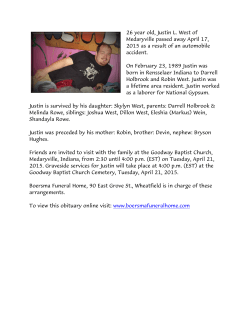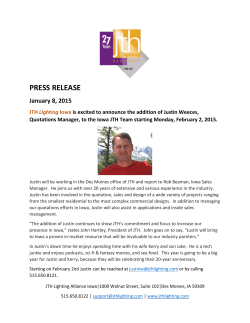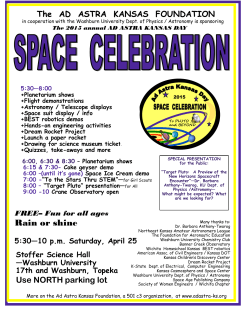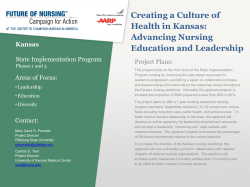
CALL FOR ABSTRACTS - The Wildlife Society
CALL FOR ABSTRACTS 2015 Annual Meeting of the Central Mountains and Plains Section of The Wildlife Society Hosted by The Kansas Chapter of The Wildlife Society and Kansas State University Submission Deadline: 26 June 2015 This is the first call for oral and poster presentations for the 2015 Annual Meeting of the Central Mountains and Plains Section of The Wildlife Society being held 10-13 August at the Bluemont Hotel in Manhattan, Kansas. Plenary sessions at the conference will address the theme: “Grassland Strongholds: Biodiversity and Management” We are accepting abstracts for oral and poster presentations by professionals and students on wildlife-related topics. Presentations pertaining to grassland wildlife and management are encouraged. Abstracts must be submitted electronically using the template on the attached page or from the Kansas Chapter of The Wildlife Society webpage on the call for papers link drupal.wildlife.org/Kansas Abstracts are due 26 June 2015 Oral presentations: 20 minutes are allotted for each presentation; 15-minute presentation followed by 5 minutes for questions and answers. Oral presentations are limited to Microsoft PowerPoint; no other formats will be accepted. Poster presentations: Maximum dimensions are 4 feet by 4 feet in size. Email abstract information as a Microsoft Word attachment to: Justin Hamilton at Justin.hamilton@ksoutdoors.com Direct questions regarding this call for papers to: Justin Hamilton Kansas Dept. of Wildlife, Parks, and Tourism 206 N. 1600 Rd. Lecompton, KS 66050 785-887-6882 (office) 785-256-5260 (cell) Justin.hamilton@ksoutdoors.com Instructions: Provide all required information in one Word document Provide the presentation title, author(s) name, authors’ affiliations, and contact author’s postal and email addresses Abstract text cannot exceed 250 words Authors will be notified the status of their submission via email by 13 July 2015 Email abstract as a Microsoft Word attachment to: Justin Hamilton at: Justin.hamilton@ksoutdoors.com ABSTRACTS ARE DUE 26 JUNE 2015 Abstract Example 1. Submitter/Author: Justin Hamilton 2. STUDENT OR PROFESSIONAL: Professional 3. Institution: Kansas Department of Wildlife, Parks and Tourism 4. Mail Address: 24421 Parallel Road Tonganoxie, KS 66086 5. Telephone/Fax Numbers: Phone 913-845-2665 6. Email Address: justin.hamilton@ksoutdoors.com 7. Submitting for the ORAL or POSTER session: Oral presentation EFFECTS OF PRESCRIBED BURNING ON GRASSLAND NESTING BIRDS ON CONSERVATION RESERVE PROGRAM AREAS IN GOVE COUNTY, KANSAS Justin V Hamilton1*, Randy D. Rodgers1, Elmer J. Finck2 1 Kansas Department of Wildlife, Parks, and Tourism, 512 Southeast 25th Avenue, Pratt, KS 67124, USA 2 Fort Hays State University, 600 Park Street, Hays, KS, 67601, USA The effects of prescribed burning on grassland nesting birds in the tallgrass prairie are well documented. Research shows some species to be more abundant in areas that have been burned recently, while others are more abundant in less disturbed grasslands. However, limited research has been conducted on the effects of prescribed burning on grassland nesting birds in the mixed grass prairie. The objectives of our research were to assess the effects of prescribed burning on vegetation and on nest site selection and nest success. In 2008, we monitored 80 nests from 9 avian species in burned and unburned areas of CRP. In 2009, we monitored 109 nests from 7 avian species on burned, unburned, and one-year post-burned areas of CRP. Our results showed no significant difference in nest density and daily survival probability of grassland nesting birds on burned and unburned areas in 2008 and burned, unburned, and oneyear post-burned areas in 2009. Significant differences in vegetation characteristics occurred between burned and unburned areas in 2008, and among burned, unburned, and one year post burned areas in 2009. A significant difference in vegetation characteristics between nest sites and random points was also observed in 2008 with percentages of forbs being greater on random sites. Our results indicated prescribed burning had no effect on nest density or daily survival probability of grassland nesting birds. However, burning did have a significant difference on vegetation characteristics, which might have contributed to differences in insect biomass.
© Copyright 2025











